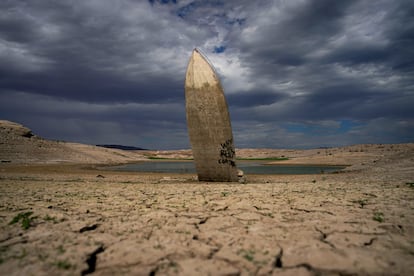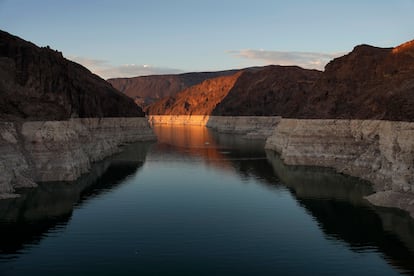Colorado River in crisis as extreme drought triggers water cuts
With levels continuing to decline, Washington will reduce allocations to Arizona, Nevada and Mexico in 2023


Two decades of drought in the southwestern United States have depleted the Colorado River and the reservoirs it feeds. Sunken ships have appeared at the bottom of the lakes, and bodies that had been submerged for decades in Lake Mead, outside Las Vegas, have been revealed, fueling theories about mob murders. Despite the crisis, western states of the Colorado River have failed to reach an agreement to reduce water from the Colorado, which forced the federal government to step in and announce cuts that will affect the states of Arizona and Nevada, as well as Mexico.
Given the 23-year ongoing historic drought and low runoff conditions in the Colorado River Basin, downstream releases from Glen Canyon and Hoover Dams – which created Lakes Powell and Mead – will be reduced again in 2023. The Bureau of Reclamation called for all seven Colorado River Basin states to conserve water over the next four years and said it will withhold 21% of Arizona’s annual allocation of Colorado River water in 2023 as the first-ever water shortage in the Colorado River Basin continues for another year, the agency said. Nevada and Mexico will face cuts of 8% and 7%, respectively.
“States have not collectively identified and adopted specific actions of significant magnitude that would stabilize the system,” Camille Touton, Bureau of Reclamation commissioner, told reporters Tuesday.
The agency did not announce cuts on the upper Colorado basin states, nor on California, which has approved water savings measures of its own. In the lower basin, the reductions represent the second year of additional shortage declarations, demonstrating the severity of the drought and critically low reservoir conditions, the agency said.
The Colorado River, at around 1,400 miles long, is the fifth-longest river in North America. Its basin extends through the states of Wyoming, Colorado, Utah, New Mexico, Arizona, California and Nevada as well as northwestern Mexico. It supplies water to cities such as Denver, Phoenix and Las Vegas. The river begins its course in La Poudre Pass, a small town located 3,100 meters above sea level in the Rocky Mountains, in Colorado. The river enters Mexico, where it forms the border between Baja California and Sonora, and flows into the Gulf of California or Sea of Cortez, in the Pacific Ocean.

Prolonged drought and low runoff conditions accelerated by climate change have led to historically low water levels in Lakes Powell and Mead. “Over the last two decades, department leaders have engaged with Colorado River Basin partners on various drought response operations. However, given that water levels continue to decline, additional action is needed to protect the system,” the bureau said in a statement.
“The worsening drought crisis impacting the Colorado River Basin is driven by the effects of climate change, including extreme heat and low precipitation,” said Deputy Secretary Tommy Beaudreau. “In turn, severe drought conditions exacerbate wildfire risk and ecosystems disruption, increasing the stress on communities and our landscapes.”
Last June, Touton appeared before the United States Senate Committee on Energy and Natural Resources and called on water users throughout the basin to take action to prevent reservoirs from falling to critically low levels that threaten water supplies and energy production.
Tu suscripción se está usando en otro dispositivo
¿Quieres añadir otro usuario a tu suscripción?
Si continúas leyendo en este dispositivo, no se podrá leer en el otro.
FlechaTu suscripción se está usando en otro dispositivo y solo puedes acceder a EL PAÍS desde un dispositivo a la vez.
Si quieres compartir tu cuenta, cambia tu suscripción a la modalidad Premium, así podrás añadir otro usuario. Cada uno accederá con su propia cuenta de email, lo que os permitirá personalizar vuestra experiencia en EL PAÍS.
¿Tienes una suscripción de empresa? Accede aquí para contratar más cuentas.
En el caso de no saber quién está usando tu cuenta, te recomendamos cambiar tu contraseña aquí.
Si decides continuar compartiendo tu cuenta, este mensaje se mostrará en tu dispositivo y en el de la otra persona que está usando tu cuenta de forma indefinida, afectando a tu experiencia de lectura. Puedes consultar aquí los términos y condiciones de la suscripción digital.
More information
Archived In
Últimas noticias
Most viewed
- Reinhard Genzel, Nobel laureate in physics: ‘One-minute videos will never give you the truth’
- Oona Chaplin: ‘I told James Cameron that I was living in a treehouse and starting a permaculture project with a friend’
- Pablo Escobar’s hippos: A serious environmental problem, 40 years on
- Charles Dubouloz, mountaineering star, retires at 36 with a farewell tour inspired by Walter Bonatti
- Why we lost the habit of sleeping in two segments and how that changed our sense of time










































